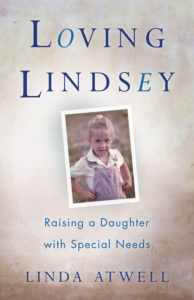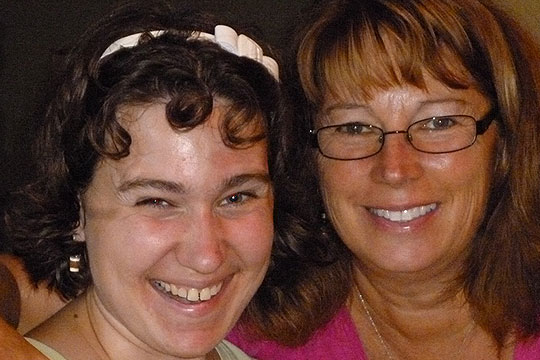Sometimes I wonder if, instead of being an advocate for my daughter, I’m a huge obstacle.
But how can that be? I want what most parents want for their kids: for my daughter to be safe, loved, happy. I want her to make wise decisions. Translation: to make the same (or similar decisions) to ones I’d make.
Lindsey would say, as parents, we’re overprotective. But I don’t believe we are. After all, Lindsey is thirty-four. She has lived (most of the last fourteen years) on her own. And successfully, that is, if you asked my daughter. Most days, we’d agree with her. We’ve supported her major decisions: landing a job; living solo in her own apartment; marrying Nick.
Over the years though, Lindsey has asked—more accurate description: demanded—more freedom. My husband and I stepped back and watched from a distance, giving Lindsey space to prove she could get up, take her medications, and get herself to work on time. (And unless she is sick, she makes it to work by her scheduled start time at least ninety percent of the time.) Since I’ve not heard otherwise, I believe she is “maintaining” on the job. But I don’t call her work and check on Lindsey. I don’t ask The Boss, “How’s my girl doing?” I know (because Lindsey has told us) that The Boss has had conversations with our daughter when she misses too much work due to illness. Lindsey worries, says she might lose her job if she doesn’t try harder. And then she tries harder. For awhile. Yet I feel the conversations between The Boss and my daughter are between them. Unless we are asked to intervene, we don’t.
John and I used to take Lindsey grocery shopping. She carried a large, #10 envelope with cash from her recent paycheck and a plastic Oregon Trail Card (a.k.a. food stamps).

“Your grocery money must last two full weeks,” I reminded my daughter calmly, watching her tighten her grip on the grocery envelope and plastic card and glare at me. I ignored the glare as we walked Safeway’s aisles and made suggestions for cheaper options, healthier choices–ways to make her grocery funds last longer. We reminded her to try and stay within her budget (half the cash to be spent for one weeks groceries, the remaining for the next). Lindsey defiantly told us our help was not helping.
“Quit cramming your ideas down my throat, Mom.” Lindsey’s words were coated with irritation. “I’m not a child anymore.” To me, my advice didn’t feel like cramming. It felt like being a good mother, a parent who was attempting to teach a daughter with special challenges simple ways to be a responsible adult.
And although I initially disagreed with my daughter’s assessment, she may have been more right than I gave her credit for. When we strolled the aisles and Lindsey ignored all my suggestions, I tensed, causing my shoulders to ache. My daughter noticed my changed demeanor and stomped down the aisle, throwing two bags of Lay’s potato chips into the shopping cart.
What it comes down to is this: we often want more for Lindsey than what she wants for herself. I’m trying to accept that. And it’s hard, because truth be told, I think I know best.
Because of her federally recognized physical and mental disabilities, Lindsey qualifies for a state provider. One of the provider’s assignments is to take Lindsey grocery shopping.“My provider treats me like a grown up,” she told me when I opened my daughter’s freezer and found twenty boxes of frozen meals. “I feel lots more independent with her. She doesn’t get into my business.”
Having a provider makes our lives a lot easier.

Yet there is one area I’ve continued to struggle with. Big time. And that is: letting Lindsey have a walker. Several years ago, after a fall on a downtown sidewalk, my girl was transported by ambulance to Silverton Hospital. Abrasions and lacerations marked her face, but she had no broken bones. The next day, Lindsey sported a purple and black eye. After, Lindsey regualarly said she was afraid she’d fall again.
“I think I need a walker, Mom,” Lindsey told me, explaining that she felt unstable and anxious. That the streets seemed to move under her feet when she stepped–as if she were trying to walk during the middle of a violent earthquake. She said that the city’s curbs appeared to vibrate the minute she tried to step up or down. Lindsey shared that getting through a crosswalk had always been hard for her, mainly because of her tremors. But now, after the fall, she was far more fearful. Often, when Lindsey froze in the middle of an intersection and couldn’t make herself take another step, townspeople came to her aid. They’d extend an elbow and Lindsey grabbed on tight, nervously making her way to the other side of the street.
“I’m scared a car is going to hit me,” Lindsey shared her biggest worry. I gave my girl suggestions on how to cope: take a deep breath; once the driver nods telling you its okay to cross the street, start walking; keep your eyes in the direction you’re headed; don’t look around, just focus. But Lindsey wasn’t buying this advice either.
I finally told her, “If your doctor agrees, we’ll buy you a walker.” But back then, Dr. Blount didn’t agree. She said that when Lindsey fell, her anxiety skyrocketed. She told my daughter she needed to build up her strength. The more she walked, the stronger and more confident she’d become. I chewed on my lower lip, silently pleased Dr. Blount sided with me. But the doctor also shared more. Based upon Lindsey (and my descriptions) Dr. Blount diagnosed Lindsey with visual vertigo–a spatial disorientation that is common in persons with balance issues. And Lindsey certainly suffered balance issues when she was outside or in wide open spaces. In the comfort of her home, a store, an office, places with four walls, Lindsey could move about like someone high on speed. Dr. Blount prescribed anxiety medication and referred Lindsey back to Oregon Health Science University (OHSU), “just in case the January fall caused additional damage.” I worried. Had the tumble aggravated Lindsey’s condition? Could Lindsey have something worse than the tremors? Like Parkinson’s? Or muscular dystrophy?
After a month of tests, OHSU doctors agreed that Lindsey suffered from visual vertigo, but they found nothing to indicate my daughter’s other physical or mental disabilities had worsened. And she had no new debilitating diseases either. Quietly the doctor told me, “It appears to be all in her head.” Lindsey heard. After that, whenever anyone asked about her increased shakiness, Lindsey would say, “The doctors say it’s all in my head.” Then she’d shrug her shoulders, acting as if that diagnosis wasn’t bothersome to her at all.
Still, every chance she got, Lindsey requested a walker. I resisted and rationalized. If it was all in her head, did she really need one? I put her request on Facebook. Friends and family offered up ideas: Tie helium balloons to the handle; get her a bell; attach a horn on the bar and let her beep, beep, beep her way through town; cover it in glitter. A total of forty-seven clever responses were left on that post. Others didn’t seem bothered by the idea of a walker, but I could not wrap my head around it. I worried Lindsey might be insisting on a walker to get more attention (it wouldn’t be the first time). Yet, deep inside, I worried my ego was blocking my judgment. With a walker, would she appear more disabled than she was? If so, would she be a greater target for predators and unscrupulous people? Would she get used to a walker and never want to give it up?
Instead of a walker, I agreed to buy her walking sticks, hoping they’d stabilize her balance. For a year and a half, they did just that. Lindsey’s confidence increased. She shared no additional scary crosswalk stories. Then without warning, the rubber tips on her walking sticks completely wore off. When she placed the exposed metal ends on a wet store floor, instead of supporting her weight, the sticks slid in different directions, and Lindsey felt her bum land on a wet floor in a thud. Now Lindsey wanted a cane. She didn’t trust the walking sticks any longer. For a while, the cane worked great too.
Then two weeks ago, with that trusty cane by her side, Lindsey again froze in a downtown intersection and was unable to cross the street without assistance. It was time, I finally decided. I couldn’t let my daughter struggle any longer. I couldn’t keep depending on townspeople to rescue her. I no longer cared if the doctor agreed with this decision. I no longer cared about my idiotic ego. I only cared about Lindsey and her need to get around our small community with confidence.
I drove my daughter to Hi-School Pharmacy and Lindsey picked the first walker she spotted. “This is perfect!” she said, not noticing it was on sale. Wise choice, I thought as I watched my daughter lift the padded seat to find a basket that could carry groceries home from the store. Lindsey squealed and lifted the seat and set it back in place several times. She giggled when her hands gripped the brakes and the walker stopped in an instant.
 Since then, Lindsey legs have zipped around downtown Silverton. She no longer freezes in crosswalks or complains about the earth moving beneath her feet. Instead, a smile brightens her face as she pushes her walker up and down the sidewalks with a newfound confidence and purpose.
Since then, Lindsey legs have zipped around downtown Silverton. She no longer freezes in crosswalks or complains about the earth moving beneath her feet. Instead, a smile brightens her face as she pushes her walker up and down the sidewalks with a newfound confidence and purpose.
Recently I overhead Nick say, “You move so fast now, Linds.” He grinned, continued. “Do you have a license to operate that thing? You better slow down or you’re gonna get a ticket.” They laughed. Apparently my girl knew–all along–that this was the secret to helping her get around.
And through this process, I’ve realized that I need to listen to my daughter. But more important than listening, I need to hear her actual words, because in the end, Lindsey may actually understand–better than her mother (at least in some cases)–what’s best for her.
Fortunately, I’m only fifty-six. I’m hoping there’s still time for me to improve on being less of an obstacle and more of an advocate.

My first book will be coming out September 26, 2017. If you are interested in learning more about Loving Lindsey: Raising a Daughter with Special Needs, please click here.

